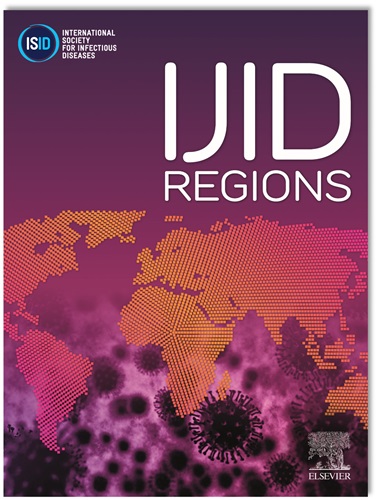Academic and social-behavioral assessment in a prospective cohort of normocephalic school-aged children with antenatal Zika virus exposure
IF 4.3
2区 医学
Q1 INFECTIOUS DISEASES
引用次数: 0
Abstract
Objectives
Long-term outcomes in children with antenatal Zika virus (ZIKV) exposure without microcephaly are unknown. We assessed academic and social-behavioral outcomes among normocephalic school-aged children with antenatal ZIKV exposure and controls.
Methods
School-aged children exposed to Zika (ZEC) and unexposed controls (ZUCs) were recruited in Rio de Janeiro, Brazil. The academic performance and strengths and difficulties questionnaire was evaluated through parental interviews. Clinical/demographic data were abstracted from medical records/interviews. Potential associations with trimester of infection, early neurodevelopment, and neuro-sensory findings were explored in ZEC.
Results
In total, 147 children were enrolled: 78 ZEC and 69 ZUCs. The mean age for ZEC was 8.1 years and the mean age for ZUCs was 7.7 years; 50.0% of ZEC and 44.9% of ZUCs were male. Reading (21.8% vs 7.2%, P = 0.0193) difficulties, writing (20.5% vs 5.8%, P = 0.0144) difficulties, and suspected/diagnosed neurodevelopmental disorders (39.7% vs 17.4%, P = 0.0036) were greater in ZEC than ZUCs. ZEC had higher scores in total difficulties (13.32 vs 10.10, P = 0.0099), emotional symptoms (4.33 vs 2.90, P = 0.0011), and hyperactivity (4.95 vs 3.41, P = 0.0037). ZIKV exposure was a predictor of reading (adjusted odds ratio [aOR] = 3.39, 95% confidence interval [CI] = 1.17-9.79), writing (aOR = 4.02, 95% CI = 1.27-12.74), emotional (aOR = 3.51, 95% CI = 1.72-7.18), and hyperactivity (aOR = 2.43, 95% CI = 1.18-4.98) problems. Early developmental delay was more frequent in ZEC with academic difficulties (P = 0.0018).
Conclusions
Antenatal ZIKV exposure is associated with increased risk of academic difficulties, neurodevelopmental diagnoses, and social-behavioral problems in school-aged normocephalic children.
产前寨卡病毒暴露的正常头畸形学龄儿童前瞻性队列的学术和社会行为评估
目的:未出现小头畸形的产前寨卡病毒暴露儿童的长期结局尚不清楚。我们评估了产前暴露于寨卡病毒和对照组的正常脑发育学龄儿童的学业和社会行为结果。方法:在巴西里约热内卢市招募学龄寨卡暴露儿童(ZEC)和未暴露对照组(ZUC)。通过家长访谈评估学业成绩和优势与困难问卷。临床/人口统计数据从医疗图表/访谈中提取。在ZEC中探讨了感染的三个月、早期神经发育和神经感觉的潜在关联。结果:共纳入147例儿童:ZEC 78例,ZUC 69例。ZEC平均年龄8.1岁,ZUC平均年龄7.7岁;50.0%的ZEC和44.9%的ZUC为男性。阅读(21.8%比7.2%,p=0.0193)、写作(20.5%比5.8%,p=0.0144)困难、疑似/诊断的神经发育障碍(39.7%比17.4%,p=0.0036)在ZEC中高于ZUC。ZEC在总困难(13.32比10.10,p=0.0099)、情绪症状(4.33比2.90,p=0.0011)和多动(4.95比3.41,p=0.0037)方面得分更高。寨卡病毒暴露是阅读(aOR=3.39,95%CI=1.17 - 9.79)、写作(aOR=4.02,95%CI=1.27 - 12.74)、情绪(aOR=3.51,95%CI=1.72 - 7.18)、多动症(aOR=2.43,95%CI=1.18 - 4.98)问题的预测因子。早期发育迟缓在有学习困难的ZEC中更为常见(p=0.0018)。结论:在学龄正常头型儿童中,产前接触寨卡病毒与学业困难、神经发育诊断和社会行为问题的风险增加有关。
本文章由计算机程序翻译,如有差异,请以英文原文为准。
求助全文
约1分钟内获得全文
求助全文
来源期刊
CiteScore
18.90
自引率
2.40%
发文量
1020
审稿时长
30 days
期刊介绍:
International Journal of Infectious Diseases (IJID)
Publisher: International Society for Infectious Diseases
Publication Frequency: Monthly
Type: Peer-reviewed, Open Access
Scope:
Publishes original clinical and laboratory-based research.
Reports clinical trials, reviews, and some case reports.
Focuses on epidemiology, clinical diagnosis, treatment, and control of infectious diseases.
Emphasizes diseases common in under-resourced countries.

 求助内容:
求助内容: 应助结果提醒方式:
应助结果提醒方式:


